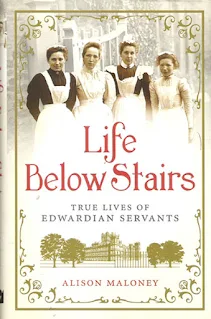The book is broken down into the following chapters to cover the different segments of a servant's work in their master and mistress' house:
- Social Background
- Household Structure
- Pay and Conditions
- A Day in the Life of a Country House
- Toil and Technique
- Special Occasions
- Code of Conduct
- Hiring and Firing
- The High Life
Here's a brief selection of interesting tidbits I learned from Life Below Stairs:
- Footmen increased in value with every inch in height as the liveried uniform was considered to look smart on the taller man. An extra premium was paid for two who were similar in stature and appearance. Page 44
- In order to go into service, a maid had to have her own uniform of a print dress, a black dress and several white aprons. Coming from poor backgrounds, as well as workhouses and orphanages saving up for these garments was no mean feat and most would have to work in part-time jobs for two years to make the money. Page 61
- Beauty products such as cold cream could be bought or mixed at home and were made from a variety of ingredients including lanolin, almond oil, cocoa butter, coconut oil, white wax, witch hazel and spermaceti - a wax obtained from the head of a sperm whale. Page 107
- Constitutional expert Alastair Bruce explains: 'The dining room chairs may have a back on them but the back is for the footman to push in and out and not for them to rest their backs on at any time.' Page 118
At less than 200 pages, Life Below Stairs is a light, enjoyable and educational read and I thoroughly recommend it to fans of the TV series Downton Abbey, and anyone with an interest in what life was really like for servants in England.
My rating = ****
Carpe Librum!



































